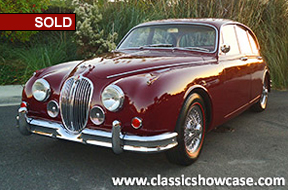1961 Jaguar Mark II 3.8 Sedan
Specifications |
|
| Stock: | J61-696 |
| Current condition: | SHOW-DRIVER |
| Performance: | 3.8L, twin SU HD6 carburetors |
| Transmission: | Automatic with overdrive |
| Color exterior: | Maroon |
| Color interior: | Maroon |
| Mileage: | 24,077 miles |
| Wheels: | Chrome Wire wheels |
| Tires: | 5 Coker Redline Classic 195/75/15 |
| Brakes: | Four-wheel disc brakes |
| Vin #: | P214696BW |
| Engine #: | LA7809-9 |
| Gearbox #: | JBC1754 |
| Other 1: | Body Number: S007678 |

Description
(SOLD)
History
The Jaguar Mark 2 is a medium-sized saloon car built from late 1959 to 1967 by the Jaguar Company in Coventry, England. Adhering to Sir William Lyons' maxim of "grace, pace and space", the Mark II was a fast and capable saloon. It came with a 120 bhp 2,483 cubic centimeters, 210 bhp 3,442 cubic centimeters or 220 bhp 3,781 cubic centimeters Jaguar XK engine. The 3.8 is similar to the unit used in the 3.8 E-Type, having the same block, crank, connecting rods and pistons but different inlet manifold and carburation (two SUs versus three on the E-Type in Europe) and therefore 30 bhp (22 kW) less. The head of the six-cylinder engine in the Mark 2 had curved ports. The 3.4- and 3.8-litre cars were fitted with twin SU HD6 carburetors. The overall appearance of the car was transformed by an increase of 18% in cabin glass area greatly improving visibility. The car was re-engineered above the waistline. Slender front pillars allowed a wider windscreen and the rear window almost wrapped around to the enlarged side windows now with the familiar Jaguar D-shape above the back door and fully chromed frames for all the side windows. The radiator grille was amended and larger side, tail and fog lamps repositioned. Inside a new heating system was supplied and ducted to the rear compartment and a new better instrument layout.
